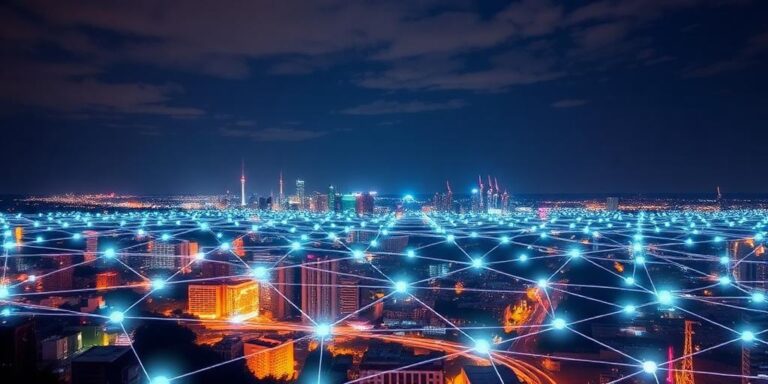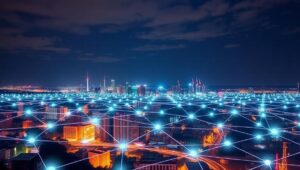Smart Grids and Energy IoT: Optimizing Power Generation and Consumption (2026)
The energy landscape is undergoing a dramatic transformation, driven by the need for greater efficiency, reliability, and sustainability. Smart grids and the Energy Internet of Things (IoT) are at the forefront of this revolution, promising to optimize power generation and consumption in unprecedented ways. This article explores the current state and future potential of these technologies, examining their impact on the energy sector by 2026.
Understanding Smart Grids
A smart grid is an advanced electrical grid that uses digital technology to enable two-way communication between the utility and its customers. Unlike traditional grids that operate on a one-way flow of electricity, smart grids incorporate sensors, smart meters, and advanced control systems to monitor and manage energy distribution in real-time. This enhanced visibility and control lead to several key benefits:
- Improved Reliability: Smart grids can detect and respond to outages more quickly, reducing downtime and improving overall grid stability.
- Increased Efficiency: By optimizing energy flow and reducing waste, smart grids minimize transmission losses and lower operational costs.
- Enhanced Security: Advanced security measures protect the grid from cyberattacks and physical threats, ensuring a more resilient energy infrastructure.
- Integration of Renewable Energy: Smart grids facilitate the seamless integration of distributed generation sources, such as solar and wind power, into the grid.
The Role of Energy IoT
The Energy IoT refers to the network of interconnected devices, sensors, and software that collect and exchange data related to energy production, distribution, and consumption. These devices include smart meters, smart appliances, and industrial sensors, which generate vast amounts of data that can be analyzed to optimize energy usage and improve grid performance. The key components of Energy IoT include:
- Smart Sensors: These devices monitor various parameters, such as voltage, current, temperature, and pressure, providing real-time data on grid conditions.
- Data Analytics Platforms: Advanced analytics tools process the data collected by sensors to identify patterns, predict demand, and optimize energy distribution.
- Communication Networks: Reliable communication networks, such as cellular, satellite, and fiber optic, enable the exchange of data between devices and control centers.
- Cloud Computing: Cloud platforms provide the infrastructure and services needed to store, process, and analyze large volumes of energy data.
Optimizing Power Generation
Energy IoT plays a crucial role in optimizing power generation by enabling better forecasting, predictive maintenance, and improved resource management. By 2026, we can expect to see the following advancements:
- Advanced Forecasting: Machine learning algorithms will be used to predict energy demand more accurately, allowing utilities to adjust generation levels accordingly and reduce reliance on fossil fuels.
- Predictive Maintenance: Sensors will monitor the condition of power generation equipment, such as turbines and generators, enabling proactive maintenance and preventing costly breakdowns.
- Resource Optimization: Energy IoT will facilitate the integration of renewable energy sources into the grid, optimizing the use of solar, wind, and hydro power based on weather conditions and energy demand.
Optimizing Power Consumption
Smart grids and Energy IoT also enable significant improvements in energy consumption by empowering consumers with real-time information and control over their energy usage. Key developments in this area include:
- Smart Meters: These devices provide detailed information on energy consumption patterns, allowing consumers to identify areas where they can reduce their energy usage.
- Demand Response Programs: Smart grids enable demand response programs, which incentivize consumers to reduce their energy usage during peak demand periods, helping to stabilize the grid and lower energy costs.
- Smart Appliances: Connected appliances can be remotely controlled and optimized to reduce energy consumption, such as automatically adjusting the thermostat or turning off lights when a room is unoccupied.
- Energy Management Systems: Home and building energy management systems provide a centralized platform for monitoring and controlling energy usage, enabling greater efficiency and cost savings.
Challenges and Opportunities
While smart grids and Energy IoT offer tremendous potential, several challenges must be addressed to ensure their successful implementation. These include:
- Cybersecurity Risks: The increasing connectivity of energy systems creates new vulnerabilities to cyberattacks, requiring robust security measures to protect the grid from malicious actors.
- Data Privacy Concerns: The collection and analysis of energy data raise privacy concerns, necessitating clear policies and regulations to protect consumer data.
- Interoperability Issues: The lack of standardized protocols and interfaces can hinder the integration of different devices and systems, limiting the benefits of Energy IoT.
- Regulatory and Policy Barriers: Outdated regulations and policies can impede the deployment of smart grid technologies, requiring regulatory reforms to facilitate innovation and investment.
Despite these challenges, the opportunities presented by smart grids and Energy IoT are immense. By addressing these challenges and leveraging the potential of these technologies, we can create a more efficient, reliable, and sustainable energy future.
Conclusion
Smart grids and Energy IoT are revolutionizing the energy sector, offering unprecedented opportunities to optimize power generation and consumption. By 2026, these technologies will play an increasingly critical role in enabling a more sustainable and resilient energy future. As we move forward, it is essential to address the challenges associated with cybersecurity, data privacy, interoperability, and regulatory barriers to fully realize the potential of smart grids and Energy IoT.




